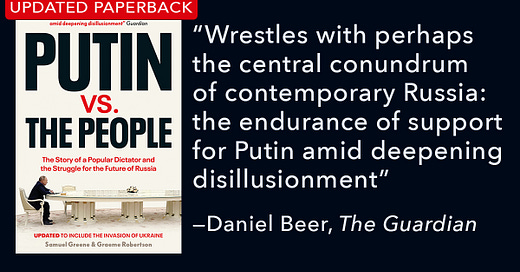Three years ago, in the summer of 2019, Graeme Robertson and I published a book that began with the following three sentences:
Vladimir Putin is a popular man. He is also a dictator. That is not a contradiction.
Earlier this year, Yale University Press reached out to me and Graeme to see whether we would be interested in a second edition of the book, Putin v the People, in paperback and revised to reflect Russia’s invasion of Ukraine. That new edition — which hits the shelves this week in the UK, and in September in the US — now begins like this:
On the 24th day of February 2022, Vladimir Putin declared a war he cannot win.
We rewrote the opening in part because the war seemed to have rewritten history. As we write in the preface to the new edition:
That [original] opening was meant to be controversial, to pull readers out of comfortable assumptions about the nature of power in Russia, and about authoritarianism more broadly. As this edition goes to press, however, no such provocation is necessary. Putin’s full-scale invasion of Ukraine—a war both barbaric and utterly senseless—has amply challenged whatever comfortable assumptions readers might have once held about Russia.
The new opening is, I think, more apt right now than the first one — but that doesn’t mean the first one was wrong. In many ways, Putin is even more of a dictator than he was three years ago. What’s more, as polling from the Levada Center suggests (below), he is now more popular than he was three years ago, and just about as popular as he was after the initial annexation of Crimea. And those two things are still not in contradiction.

The bigger challenge in revising the book, though, wasn’t how to begin it: it was what to do with the book’s core argument. More precisely, the task was to figure out how to convince readers that the core argument still matters, given that that argument — like the first three sentences of the first edition — is still true. Now more than ever, it’s tempting to think about Putin’s power as imposed from above, the result of an all-powerful security state imposing its will on an entirely unwilling population. Now more than ever, it’s important to push back against that idea.
Graeme and I remain very far from blaming Russians for their own political plight, or from denying the considerable coercive power that the Kremlin has amassed. But to focus too much on those factors is a mistake, we argue. As we write in the new concluding chapter:
The book explains that ‘co-construction’ better and in more depth than I can do here, but in a nutshell it draws on extensive survey research and other approaches to show the ways in which horizontal ties of socialization among ordinary Russians — rather than vertical ties of coercion from state to citizen — have been the source of Putin’s power for the past two decades. (Some of the thicker social science behind this can be found here, here and here.)
But could this be changing? Could we be witnessing co-deconstruction?
The answer is maybe. Russian politics has been on a trajectory towards harsher authoritarianism for quite some time. And as I wrote earlier this summer, the Kremlin’s approach both to the organized opposition, to street protests and, in particular, to the media suggests that it is transitioning away from what Dan Treisman and Sergei Guriev have called a “spin dictatorship” to a more traditional “fear dictatorship”.
It’s hard to see how a system of power based more on coercive vertical relations than on social horizontal relations could be compatible with the kind of co-construction of power that Graeme and I describe. But it’s equally hard to see how a system of power based in horizontal social ties could easily yield to something very different. Again to excerpt the book:
Almost six months into the war, we remain unable to grasp the full magnitude of what Putin has unleashed, or to chart a course towards peace. The updated, paperback edition of Putin v the People addresses these challenges, by re-contextualizing the history and social science of contemporary Russian politics to account for this war. Much of the book — including the five empirical chapters, where the argument on co-construction is developed and evidenced — remains unchanged (which is good news for any kind academic souls who have cited the original). But much of the first chapter and all of the final chapter are new.
Taken together, the old and new sections explain how Putin's rule has been built and rebuilt over the past two decades, the complex set of relationships that have allowed Russia's president to remain powerful even as he deprived his citizens of freedom and prosperity, the tools Putin will use to cement his power, and the challenges he will face in doing so.





